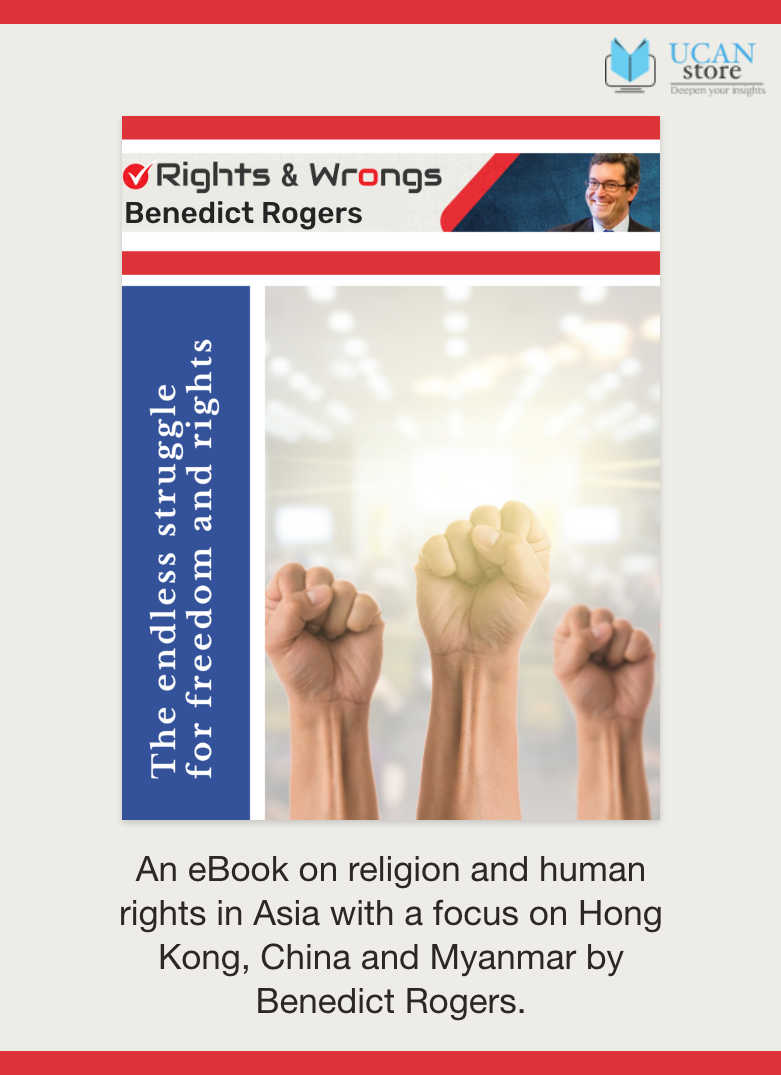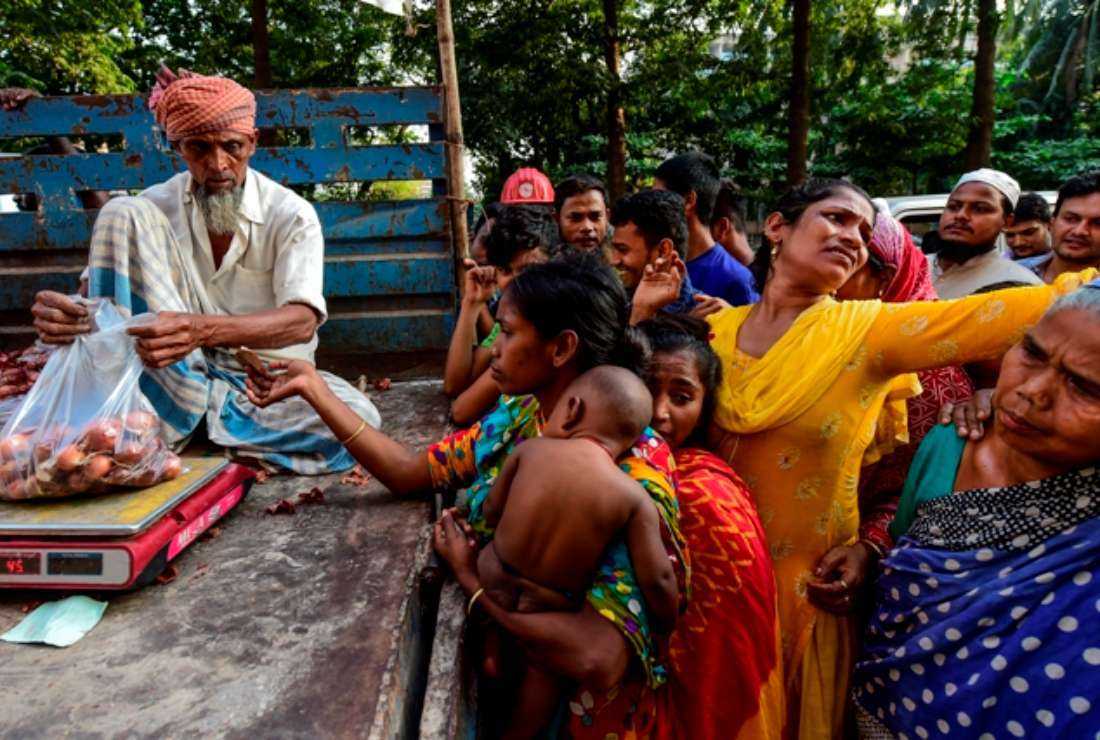
Impoverished ethnic minorities struggle for survival amid a lack of income and a high cost of living

Bangladeshi people queue for buying food in Dhaka on Nov. 14, 2019. The poor, especially the impoverished ethnic minorities, now struggle for survival amid a lack of income and a high cost of living in the South Asian nation. (Photo: AFP)
This year, Easter Sunday brought no cheer for hundreds of poor Santal Christians in the Bagdafarm area of northern Bangladesh.
The community, like millions of Bangladeshis, suffered from days of record-high temperatures, and frequent power cuts.
Adding salt to the wounds, the mostly farming Santal community lost about 30 percent of rice yields as soaring inflation made irrigation costlier and unaffordable.
The grim situation is blamed on the impacts of the Covid-19 pandemic, the Ukraine War, and rising inflation in the South Asian nation of more than 165 million.
“The poor are having the worst time of their life and they need immediate help,” said Philemon Baske, a Santal leader in Gaibandha district that covers the Bagdafarm area.
Life was never so dull and full of tension, he said, recalling the somberness that dominated the celebration of Easter Sunday on April 9.
“Losing 30 percent production is bad news for the poor, particularly in this difficult time,” said Baske.
He is particularly concerned for the critically ill after having witnessed several deaths over the last three months which many Santals believe could have been prevented with treatment.
According to the nation’s central bank, Bangladesh Bank, inflation rose by 50 percent in March 2023, compared to the same month last year.
In March 2023, inflation stood at 9.33 percent, according to the central bank.
Poor minorities hit hard
Prosenjit Kora, 16, a member of the Kora community, a tiny ethnic minority group found in two villages in the northern Dinajpur district bordering India, fell silent when asked about what he had for lunch.
After a protracted silence, Prosenjit said that he had puffed rice with eggplant curry, eggplant boiled with salt.
“We did not have any ordinary rice to eat," he said, “Puffed rice is something that needs no curry to be eaten with while a little amount of it makes one feel full.”
He said he was uncomfortable telling his family’s story of how they survived the pandemic and its impacts.
For poor people like Prosenjit, puffed rice has become even costlier than rice, the staple food.
Research studies suggest that the average price of rice had jumped by 25 percent in the past two years. This year, rice became pricier as the cost of production increased by about 20 percent.The impact is felt by the poor, who make up about one-fifth of the population, in both rural and urban areas.
Independent think-tank, the Center for Policy Dialogue (CPD), reported last October that average monthly food costs for a four-member family in the capital Dhaka increased by almost 22 percent, compared with food prices in January 2019.
Excluding protein on the menu, the cost of food increased by almost 40 percent, the CPD said, warning that the number of poor might rise because of inflation.
The ordeal for 28 Kora families in Dinajpur has gone from bad to worse.
Many families now skip meals more frequently and more kids are being sent to work than they used to.
“I stopped going to school two years ago,” said Prosenjit, who now works in rice and maze fields and sometimes travels 10 kilometers looking for work.
Back at home, Kora women like members of other ethnic groups search for food in a nearby forest. The rapidly shrinking forest of Birol, an area where the Kora village of Jhinaikuri is located, has only wild vegetables to offer.
“Kids are beyond bored eating these vegetables all the time,” said Ronita Lakra, from the Oraon ethnic group and a mother of three.
Kora and Oraon are among the most disadvantaged ethnic minority groups in Bangladesh.
Kora people struggled to have enough to eat even before the pandemic struck. Their poverty and marginalization were rarely the subject of economic studies.
Hunger haunts all the poor
The situation is not much better for the majority poor either, government and independent studies revealed.
The South Asian Network on Economic Modeling (SANEM) revealed in March this year that 37 percent of low-income people are sometimes forced to skip a meal and 90 percent of the studied poor shed protein from their diet, both in urban and rural areas.
The SANEM study found that the poor generally cut their education, medical and other expenses and that 74 percent of the studied families adopted borrowing as a strategy to cope with rising inflation.
In January, Bangladeshi people faced the worst inflation in 11 years, the Consumers Association of Bangladesh (CAB) reported after monitoring prices of more than 200 food and non-food items.
The CAB also reported that frequent energy price hikes, up to 50 percent, drove up the price of food and other items by nearly 20 percent in Dhaka in the second half of 2022.
Professor Mustafizur Rahman, a distinguished fellow at the CPD, however, said that the figures do not reveal the actual scenario.
“The actual inflation experienced by the poor is way higher than reported,” he asserted.
Rahman said many poor families lost their income partially or completely, immediately after the Covid-19 pandemic hit Bangladesh in March 2020, about two years before the war between Russia and Ukraine broke out, triggering a rare energy shock and sticky inflation.
“How the disadvantaged minority communities are amidst all these shocks is basically unknown to mainstream society,” he said.
A study on marginalized people by the Center for Peace and Justice (CPJ) of BRAC University in Dhaka, revealed last year that the monthly income of rural poor, slum dwellers, and ethnic minorities was 10 percent lower in December 2021, compared with the pre-pandemic level.
The study revealed that the poor and the marginalized began adopting strategies such as cutting food consumption, taking up low-wage jobs, and withdrawing their savings by the end of 2021.
Debt-trap
Energy prices went up twice in 2022, by up to 50 percent, and then again four times, up to 179 percent, in the first quarter of this year.
Economists have warned that inflation might not have peaked yet.
In 2021, over 45 percent of the urban poor and nearly 50 percent of the rural poor reportedly lost their jobs because of the pandemic, said Hossain Mohammed Omar Khaiyum, the lead author of the CPJ study.
“People rushed for high-interest non-formal loans immediately after the Covid-19 pandemic,” he said.
Without work and then food prices rising, most poor people defaulted on their debts and resorted to a second loan to keep their lenders from suing them over non-payment.
“Many poor are now caught in a debt trap,” said Khaiyum.
The majority of Bangladesh’s 20 million farmers are mostly poor smallholders, landless, and sharecroppers, and are no strangers to the debt trap.
After Covid-19 struck, farmers were forced to borrow repeatedly to make up for inadequate crop prices, increased production costs, and losses inflicted by natural disasters.
Like food, inflation triggered price rises of all agricultural materials, leading to a 20 percent rise in the production cost of rice this year, plunging many farmers into further debt.
Agricultural economists fear high inflation is discouraging rice farming.
The agriculture sector employs about 55 percent of the country’s labor force and accounts for about 12 percent of the GDP. Agriculture, the ready-made garment industry and manpower exports are the lifeline of Bangladesh’s economy.
The poor are the main force sustaining these three sectors badly affected by inflation and other problems.
"I know families of garment workers eating rotten vegetables almost for a month," said Kalpona Akter, president of the Bangladesh Garment and Industrial Workers Federation.
Months of poor nutrition left many workers frail, unable to work long hours in crowded factories, Kalpona said, adding that workers fainted more frequently than ever before in factories during summer that witnessed temperatures exceeding 40C in Dhaka in April.
Haunted by layoff fears, garment workers were in no position to protest against salary cuts and irregular payment.
Garment factory production dropped, some industrialists say by 30 percent, because of the energy crisis. This severely affected the income of the poorly paid workers.
An entry-level worker earns 8,000 taka (US$75) basic salary a month. The industry employs 4 million people, mostly poor rural women.
Undignified return to home
Sneho Chakma, 43, a garment worker from Savar, near Dhaka, said he was forced to send his family back to their home village in Naniarchar, Rangamati, a district in southeast Bangladesh, in January.
“Nobody knows better than a garment worker about life struggles,’” said Chakma, adding that his income halved after the pandemic struck and the cost of living skyrocketed.
Chakma said he used to earn about 60,000 taka per month from regular work and overtime pay.
“I am poor now," he said, adding that he has moved into a single-room from a three-room apartment.
A Buddhist who is also general secretary of the Buddhist temple management committee in Palashbari, Savar, Chakma said that about 13,000 members of their minority community had returned to their villages after the pandemic hit.
Buddhist festivals in the area lost their splendor and grandeur amidst shrinking income and community size.
In Bagdafarm, poor Santals not only struggle for lack of food but also lack of money for health treatment said Philemon Baske.
He said he knows three people who are in public hospitals almost without treatment as they do not have money to afford the increased cost of diagnosis and medicine.
“I have an ominous feeling that more Santal families are going to see their loved ones die,” he said.
Help us keep UCA News independent
The Church in Asia needs objective and independent journalism to speak the truth about the Church and the state.
With a network of professionally qualified journalists and editors across Asia, UCA News is just about meeting that need. But professionalism does not come cheap. We depend on you, our readers, to help maintain our independence and seek that truth.
A small donation of US$2 a month would make a big difference in our quest to achieve our goal.

Share your comments